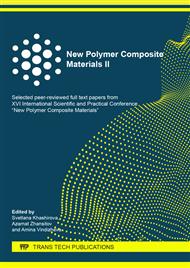[1]
V.G. Batrakov, Concrete modifiers; new opportunities and perspectives, J. Build. Materials. 10 (2006) 4-7.
Google Scholar
[2]
A. Ghulam, I. Sonny, R.M. Khalil, K. Javed, Application of cellulose‑based polymers in oil well cementing, J. of Petroleum Exploration and Production Technology. (2019) 1-7.
Google Scholar
[3]
Z. Lu, X. Zhou, The waterproofing characteristics of polymer sodium carboxymethyl-cellulose, J. Cement and Concrete Research. 30 (2000) 227-231.
DOI: 10.1016/s0008-8846(99)00233-1
Google Scholar
[4]
S. Jacquart, D. Poquillon, G. Dechambre, S. Cazalbou, C. Rey, C. Combes, Mechanical properties of self-setting composites: influence of the carboxymethylcellulose content and hydration state, J. of Materials Science, Springer Verlag. 51 (2016) 4296-4305.
DOI: 10.1007/s10853-016-9739-4
Google Scholar
[5]
M.S. El-Feky, P. Youssef, A. M. El-Tair, S. Ibrahim, M. Serag, Effect of nano silica addition on enhancing the performance of cement composites reinforced with nano cellulose fibers, J. AIMS Materials Science. 6 (2019) 864-883.
DOI: 10.3934/matersci.2019.6.864
Google Scholar
[6]
P.C. Mishra, V.K. Singh, K.K. Narang, N.K. Singh, Effect of carboxymethyl-cellulose on the properties of cement, J. Materials and Engineering A. 357 (2003) 13-19.
DOI: 10.1016/s0921-5093(02)00832-8
Google Scholar
[7]
V.S. Ramachandran, Concrete Admixyures Handbook, 2nd Ed., (2010).
Google Scholar
[8]
V.T. Fomichev, V.T. Erofeev, D.V. Emel'yanov, A.A. Matviyevskiy, E.A. Mitina, Vliyaniye elektrodnykh reaktsiy v protsessakh elektromagnitnoy aktivatsii prirodnoy vody na svoystva betona, Fundamental'nyye issledovaniya. 4 (2015) 145-151.
Google Scholar
[9]
G. Arunkarthik, S. Sivakamasundari, Experimental study on flexural behaviour of reinforced concrete beam using magnatic water, Int. J. of Civil Engineering and Technology. 8 (2017) 518-525.
Google Scholar
[10]
N.P. Gorlenko, Yu.S. Sarkisov, N.V. Subbotina, Activation of Structure Formation Processes in Cement Systems by Magnetic Field, J. Inorg. Mater. Appl. Res. 10 (2019) 237-241.
DOI: 10.1134/s2075113319010118
Google Scholar
[11]
M.V. Akulova, T.E. Slizneva, P.B. Razgovorov, A.G. Sokolova, Fine Grain Concrete on Mixing Water Activated in Cavitation Permanent Magnet-Type Apparatus, J. Key Engineering Materials. 816 (2019) 279-284.
DOI: 10.4028/www.scientific.net/kem.816.279
Google Scholar
[12]
O.G. Dubrovskaya, V.A. Kulagin, E.S. Sapozhnikova, F.-Ch. Li, Q. Li, Z.-Y. Zheng, Mathematical Modeling of Cavitation Processes in Conditioning Industrial Wastewater, J. Siberian Federal University. Engineering & Technologies. 3 (2015 8) 369-376.
DOI: 10.17516/1999-494x-2015-8-3-369-376
Google Scholar
[13]
Z. Wang, J. Ayarza, A.P. Esser-Kahn, Mechanically Initiated, Bulk Free Radical Polymerization, Angew Chem Int Ed Engl. 58(35) 2019 12023-12026.
DOI: 10.1002/anie.201903956
Google Scholar
[14]
N. Willis-Fox, E. Rognin T.A. Aljohani, R. Daly, Polymer Mechanochemistry: Manufacturing Is Now a Force to Be Reckoned With, J. Chem. 4 (2018) 1-39.
DOI: 10.1016/j.chempr.2018.08.001
Google Scholar
[15]
V.I. Popov, Mechanical activation of the transfer process in polymer systems, J. of Applied Mechanics and Technical Physics. 53 (2012) 880-886.
Google Scholar
[16]
F.L. Buchachenko, Nanokhimiya – pryamoy put' k vysokim tekhnologiyam novogo veka, Uspekhi khimii. 72 (2003) 419-437.
Google Scholar
[17]
K.M. Wiggins, J.N. Brantley, C.W. Bielawski, Methods for activating and characterizing mechanically responsive polymers, Chem. Soc. Rev. 42 (2013) 7130-7147.
DOI: 10.1039/c3cs35493h
Google Scholar
[18]
P.A. May, J.S. Moore, Polymer mechanochemistry: technologies to generate molecular force via elongation flows, Chem. Soc. Rev. 42 (2013) 7497-7506.
DOI: 10.1039/c2cs35463b
Google Scholar
[19]
M.S. Nakhamson, V.G. Feklicheva, Diagnostika sostava materialov rentgeno-difraktsionnymi i spectral'nymi metodamu, Mashinostroeniye, Leningrad, (1990).
Google Scholar
[20]
A.R. West, Solid state chemistry and its applications, Departament of Chemistry University of Aberdeen, Chichester, New York, Brisbane, Toronto, Singapure, (1987).
Google Scholar


